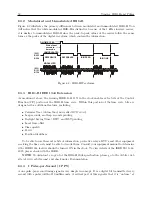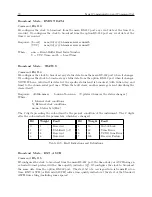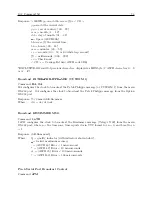
9.2 Event Inputs
59
Data for individual recorded events can be recalled using either the Event/Deviation front panel
key or via the RS-232C interface (see Section 10.2.4). Data for each event will be retained until it
is retrieved using one of these two methods. Thus, if no event data points are retrieved, recording
will be suspended when the total number of event buffer is full. As soon as data is retrieved for a
recorded event, its address is made available for data corresponding to a new incoming event.
9.2.2
Event Timing Latency
Event data are recorded using a high-speed capture circuit operating with a 4 MHz time-base.
Latency is limited by the interrupt processing speed of the clock’s microcontroller, which in turn
depends on its workload at the time the event is received. Since the workload varies from time
to time, latency likewise varies. However, response time will, in general, never be less than a few
hundred microseconds nor greater than 10 milliseconds.
9.2.3
Deviation Measurement
The Channel A input can also be configured to display measured event times as 1 pulse-per-second
(1 PPS) deviation measurements. The intended purpose of the deviation measurement function is
to allow comparison of an external 1–PPS signal to the clock’s internal 1–PPS signal. The clock
determines the mean time difference between the two signals, which can be displayed on the front
panel or read via the RS-232 Interface.
9.2.4
Measurement Principle
The measurement technique employed for 1–PPS Deviation uses the same time determination and
recording scheme used for event time measurement (refer to paragraph above), but makes the
assumption that the input signal is periodic and continuous. Also, the operation of the circular
memory buffer is modified somewhat, in that recording does not stop after the buffer is full; new
Event Data is given priority over existing data, and will overwrite it. Since the incoming signal
occurs once per second and the circular buffer holds a number of events, each event time record
will be overwritten on a regular basis.
Once every second, the processor looks at the most recent group of 16 events. When computing
deviation, it uses only the portion of the event data describing fractional seconds (e.g. values
between 0.0000000 and 0.9999999 seconds). By normalizing the 16 fractional-second values around
0.0000000, the range of results from the deviation computations will be centered on zero (-0.4999999
to +0.5000000 seconds). Statistical computations are then performed on the 16 values to determine
their Mean and Sigma (Standard Deviation) values, which are then displayed on the front panel or
output via RS-232.
9.2.5
Event Timer Input Channel Configuration
In order for the Model 1092A/B/C or 1093A/B/C to receive a timing input, adjustments to both
the hardware and software configuration may be required. The hardware configuration is described
in Section 5.3.4.
Содержание 1092A
Страница 4: ...iv ...
Страница 18: ...xviii LIST OF TABLES ...
Страница 129: ...C 10 Option 20A Four Fiber Optic Outputs 111 Figure C 7 Option 20A Jumper Locations ...
Страница 131: ...C 11 Option 27 8 Channel High Drive 113 Figure C 8 Option 27 Jumper Locations ...
Страница 148: ...130 Options List Figure C 10 Option 29 Connector Signal Locations ...
















































